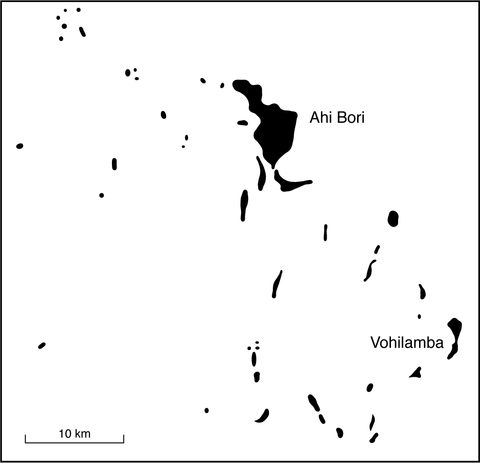stripes
In the area lying between the Amparihy and Manampatrana Rivers there are numerous occurrences of phonolite and nepheline syenite, extending over an area of about 35x25 km, which are mainly in the form of intrusions that have weathered to domes and spines but there are also remnants of flows. More than 40 occurrences are shown on the map accompanying Jérémine and Lenoble (1952) the largest of which are Ahi Bory, of about 6x3 km, and the rather smaller Vohilamba. The phonolitic rocks are characterised by the presence of hauyne and sodalite, but nepheline and analcime also occur; the feldspar is variably anorthoclase, orthoclase and albite, aegirine may be accompanied by amphiboles, including arfvedsonite, barkevikite and katophorite, and aenigmatite is also abundant. A mineral identified as ‘hainite’ by Jérémine and Lenoble (1952) may be rosenbuschite or gotzenite (Clark, 1993). The rocks of the major Ambohi Bory intrusion contain large phenocrysts of sanidine and smaller crystals of hauyne and aegirine-augite, zoned to aegirine, set in a matrix of alkali feldspar and nepheline; barkevikite occurs in some facies. Both Lacroix (1923) and Jérémine and Lenoble (1952) describe tahitites that contain phenocrysts of augite, hornblende, hauyne and rare plagioclase set in a matrix of orthoclase, plagioclase, analcime, nepheline and accessory titanite and apatite. Analyses of rocks are given by Lacroix (1923) and Jérémine and Lenoble (1952).
CLARK, A.M. 1993. Hey’s mineral index. Natural History Museum and Chapman & Hall, London. 852 pp.JÉRÉMINE , E. and LENOBLE, A. 1952. Sur les phonolites du N.E. de Madagascar. Bulletin du Muséum National d’Histoire Naturelle, Paris, Ser 2. 24: 442-51.LACROIX, A. 1923. Minéralogie de Madagascar. 3. Lithologie Appendice - Index Geographique. Société d’Éditions Géographiques, Maritimes et Coloniales, Paris. 450 pp.

